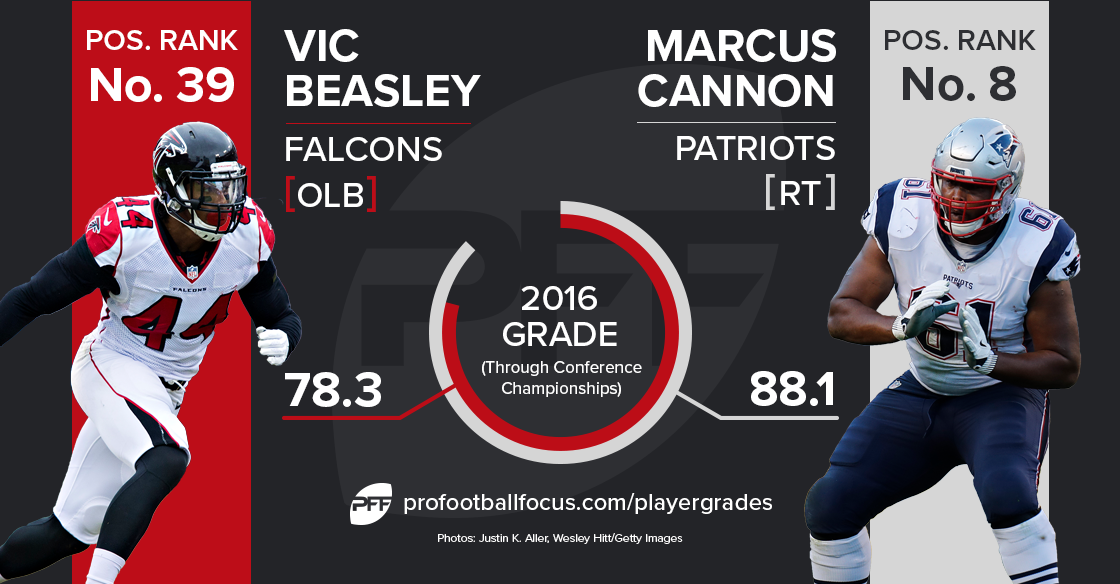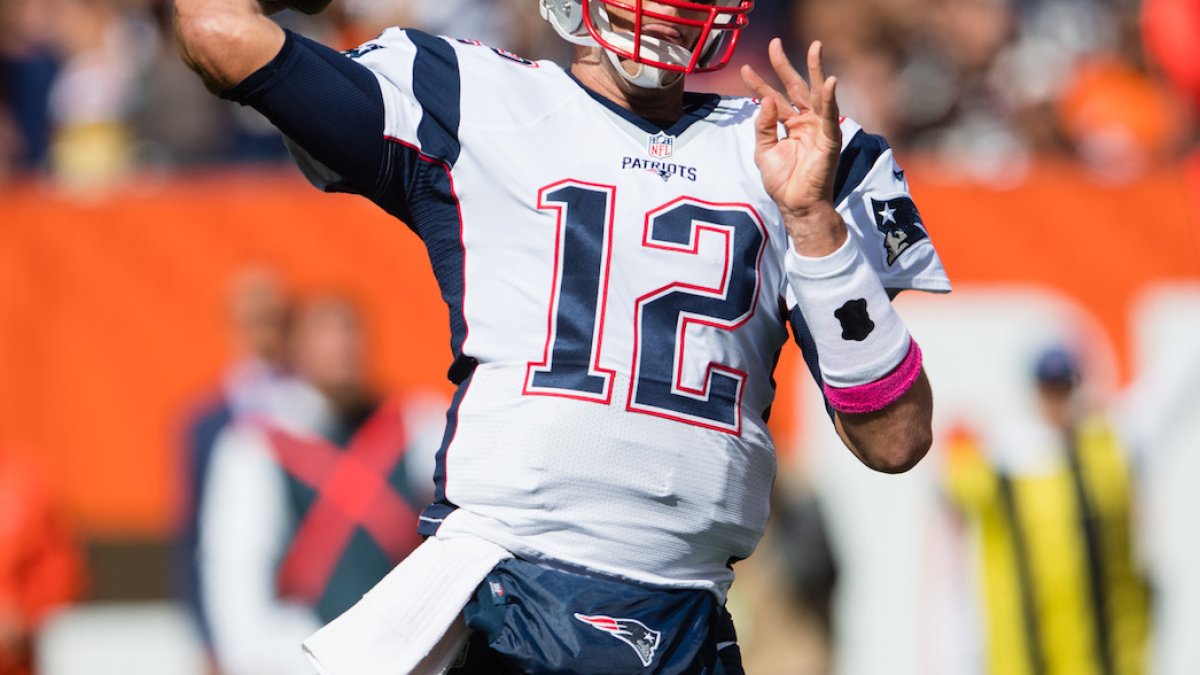Over the years, the New England Patriots' offense has set the blueprint on how to schematically attack opposing defenses. They have the flexibility with their personnel and formations to consistently give their players the advantage in individual matchups. With quarterback Tom Brady playing the best football of his career—virtually mistake-free, in fact—the offense has been one of the most efficient all season.
Atlanta's fast, but young, defense has become much improved over the course of the season. The Falcons are fairly simplistic in their design, allowing their youth to line up and play fast and decisive. They are very similar to the Seattle Seahawks in that they deploy a predominantly a single-high-safety defense, with 82 percent of their snaps being either cover-3 single-high zone or cover-1 man.
The Falcons' defense, on paper, is the weakest of the units on either side of the ball in the Super Bowl. What can they do to try and slow down this Patriots' attack? Here are the keys to watch when the Patriots have the ball.
How Atlanta will attempt to pressure Tom Brady
The matchups on the edges with OLB Vic Beasley versus RT Marcus Cannon and LT Nate Solder versus Dwight Freeney are going to be fun to watch. Beasley wins with speed to the outside, but will not likely be able to bull or win inside against Cannon. Pressure may come on the blind side at times, as Freeney is still more than capable of creating his share of pressures in a variety of ways. Tom Brady has as good of a feel for edge rushers as anyone, knowing when to step up, so an interior pass rush from Grady Jarrett is going to need to be there. If the Patriots QB is consistently stepping up into clean pockets, it could be a long day for the Falcons.

The Falcons can not win this game strictly rushing with their front four. Atlanta will likely try to utilize five-man fronts with line stunts coming in different directions along the defensive line. This will require the Falcons' secondary to, for the majority of the time, play man-to-man coverage behind it, so there is obvious risk involved.
Five-man pressures with tight man-to-man coverage on the outside have been an issue for the Patriots at times, but only when the coverage defenders are playing at a high level and are tight in coverage. If Atlanta can mix in five-man pressures early in the game, it will likely help to create pressure on Brady.
How New England can control the ball
We’ve heard the talk all week about how the Falcons having good speed on defense. They are a penetrating, up-the-field defensive front with active linebackers moving well sideline to sideline. The Patriots will use the Falcons' speed against them, running right at Atlanta in their man-blocking schemes, utilizing a variation of traps as well to slow down the penetration from interior defenders Grady Jarrett and Ra’Shede Hageman. The Falcons are susceptible to runs between the tackles, as they give up 5.1 yards per rush on such plays.
The flow of the game will dictate how the Patriots want to attack them. Keeping Atlanta in nickel personnel with tight formations and running downhill at them could be an effective way to get the ground game going. This would give them simpler defensive fronts and keeps the Falcons' offense off the field for stretches at a time.
If the Falcons can play fast but still stay gap-sound in the running game, it will bode well for them. If they get out of control and jump around blocks at the wrong times, the Patriots may be able to control some of this game on the ground. The Falcons give up a league worst 2.9 yards after contact per attempt, a number they will need to be much lower.
Falcons must win in man-to-man coverage
As we saw in the AFC Championship game, if you play softer spot drop zones against Tom Brady, he will dice you up. He’s too patient and disciplined, and the receivers have a great understanding of where the creases are in the zones. While the Falcons' cover-3 zones have different variations than what we saw from the Steelers, it will be difficult to win this game unless they heavily rely on cover-1 man-to-man coverage when they need it.
The Patriots understand exactly how to schematically attack Atlanta's cover-3 style zones. At this time, the Falcons don’t have the experience or pass rush to make a living off of their cover-3 zone scheme in this game. It's difficult to highlight one coverage player for the Falcons, because collectively, they will all have to be at their best. Ricardo Allen will need a big game patrolling the middle of the field, but will also need to be sharp mentally, as he is the key communicator in getting guys lined up across the board.
In the NFC Championship game, the Falcons deployed cover-1 man-to-man 41 percent of the time. They saw a large amount of success, limiting Rodgers and the Packers to just 12 receptions on 20 attempts passing for 102 yards, averaging out to just 5.1 yards per attempt. Although the Falcons didn’t face the formation complexities like they’ll see from the Patriots, if they can resemble this type of play effectively in man coverage, Atlanta will have a chance to slow down Brady and the New England offense.
Handling motion, empty, bunch, and stack WR sets
With the Falcons expected to play more man-to-man, this plays right into the hand of what New England likes to do. The Patriots run bunch and stack WR sets as much as anyone to free up the release of the receiver and create the leverage advantage in their favor. The style in which the Falcons play these type of looks when playing man-to-man is a “lock” technique, meaning their are no switch-offs between defenders, depending on where the receiver departs on their given route.
The Patriots typically feast when knowing the way opponents play motion stacks and bunches, and will likely use this a lot to give them the advantage. This can cause rubs and free up receivers in a big way.
Another formation fans are accustomed to seeing the Patriots run is empty, no-back sets. This is used a lot of the time with tempo to get base coverage looks from the defense, and the Falcons must devise a good game plan, because they are likely to see it often. The Texans saw a lot of success in the Divisional Round by rushing three and dropping eight into coverage as one of their empty checks; this may be a good way of defending the Patriots at times through the course of the game.
Falcons' defense in the red zone
Given all we've covered, limiting the Patriots to field goals in the red zone is the top priority defensively for the Falcons. Atlanta is last in the NFL in red-zone touchdown percentage, giving up a touchdown on 72.1 percent of red-zone trips. On the other side, the Patriots are ninth in red-zone touchdowns, finishing with touchdowns on 63.7 percent of their trips.
How the Falcons can stop the run and mix up their red-zone coverages when New England gets inside the 10-yard line will be vital in how this game goes for Atlanta defensively. The Falcons' zones don’t change much schematically as they get closer to the goal line; they'll need to man up in those situations and be ready for rub routes. Brady’s ability to extend the play and create outside the scheme down inside the 10 has been exceptional all season long, and may be put to the test again.
Bottom line
The Falcons' blueprint for trying to limit the Patriots offensively is more simplistic schematically and relies on sheer execution. Expect the Patriots' first 15 plays of the game to be aggressive, with a multitude of personnel groupings and formations trying to give them an initial shock with tempo, and force communication with a young Falcons' team. Much like the Patriots' defensively, the Falcons must feel like, if they can hold New England to under 30 points, that they have more than a great chance to win the game.
As much as we can talk about the complicated factors that go into each play, this game will still be decided on the individual matchups up front and in man-to-man coverage on the back end.



 © 2024 PFF - all rights reserved.
© 2024 PFF - all rights reserved.